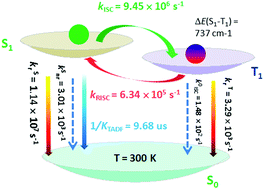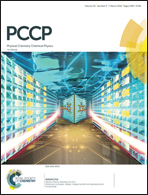Basic photophysical analysis of a thermally activated delayed fluorescence copper(i) complex in the solid state: theoretical estimations from a polarizable continuum model (PCM)-tuned range-separated density functional approach†
Abstract
A quantitative understanding of photophysical processes is fundamental for designing novel thermally activated delayed fluorescence (TADF) materials. Taking a Cu(pop)(pz2Bph2) crystal as a typical TADF molecular model, we computed the conversion and decay rates of the first excited singlet state (S1) and triplet state (T1) at different temperatures by employing the thermal vibration correlation function (TVCF) approach. For the consideration of the solid-state environment, a methodology, which is based on the combination of a nonempirical, optimally tuned range-separated hybrid functional with the polarizable continuum model, was applied. Our calculated results are in excellent agreement with the experimentally available data. It is found that the reverse intersystem crossing (RISC) from T1 to S1 proceeds at a rate of kRISC = 6.34 × 105 s−1 and can compete with the radiative decay rate (kTr = 3.29 × 103 s−1) and nonradiative intersystem crossing rate (k0ISC = 1.48 × 102 s−1) of T1 at 300 K. This implies that the S1 state can be repopulated from the T1 state, TADF should be observed and the TADF decay time was found to be τ (300 K) = 9.68 μs by fitting calculations. In addition, the calculations indicate that the free rotation of the phenylene ring in the pop ligand can provide an important channel to energy conversion between T1 and S1. But, at a low temperature of T < 100 K, the situation will experience a larger change. The RISC rate becomes very small, kRISC ≪ kTr or kISC, and it cannot induce an occurrence of delayed fluorescence. As a consequence, Cu(pop)(pz2Bph2) is a highly attractive candidate for applications of TADF.



 Please wait while we load your content...
Please wait while we load your content...